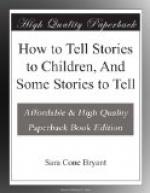It is a very old, a very beautiful art. Merely to think of it carries one’s imaginary vision to scenes of glorious and touching antiquity. The tellers of the stories of which Homer’s Iliad was compounded; the transmitters of the legend and history which make up the Gesta Romanorum; the travelling raconteurs whose brief heroic tales are woven into our own national epic; the grannies of age-old tradition whose stories are parts of Celtic folk-lore, of Germanic myth, of Asiatic wonder-tales,—these are but younger brothers and sisters to the generations of story-tellers whose inventions are but vaguely outlined in resultant forms of ancient literatures, and the names of whose tribes are no longer even guessed. There was a time when story-telling was the chiefest of the arts of entertainment; kings and warriors could ask for nothing better; serfs and children were satisfied with nothing less. In all times there have been occasional revivals of this pastime, and in no time has the art died out in the simple human realms of which mothers are queens. But perhaps never, since the really old days, has story-telling so nearly reached a recognised level of dignity as a legitimate and general art of entertainment as now.
Its present popularity seems in a way to be an outgrowth of the recognition of its educational value which was given impetus by the German pedagogues of Froebel’s school. That recognition has, at all events, been a noticeable factor in educational conferences of late. The function of the story is no longer considered solely in the light of its place in the kindergarten; it is being sought in the first, the second, and indeed in every standard where the children are still children. Sometimes the demand for stories is made solely in the interests of literary culture, sometimes in far ampler and vaguer relations, ranging from inculcation of scientific fact to admonition of moral theory; but whatever the reason given, the conclusion is the same: tell the children stories.
The average teacher has yielded to the pressure, at least in theory. Cheerfully, as she has already accepted so many modifications of old methods by “new thought,” she accepts the idea of instilling mental and moral desiderata into the receptive pupil, via the charming tale. But, confronted with the concrete problem of what desideratum by which tale, and how, the average teacher sometimes finds her cheerfulness displaced by a sense of inadequacy to the situation.
People who have always told stories to children, who do not know when they began or how they do it; whose heads are stocked with the accretions of years of fairyland-dwelling and nonsense-sharing,—these cannot understand the perplexity of one to whom the gift and the opportunity have not “come natural.” But there are many who can understand it, personally and all too well. To these, the teachers who have not a knack for story-telling, who feel as shy as their own youngest scholar at the thought of it, who do not know where the good stories are, or which ones are easy to tell, it is my earnest hope that the following pages will bring something definite and practical in the way of suggestion and reference.




